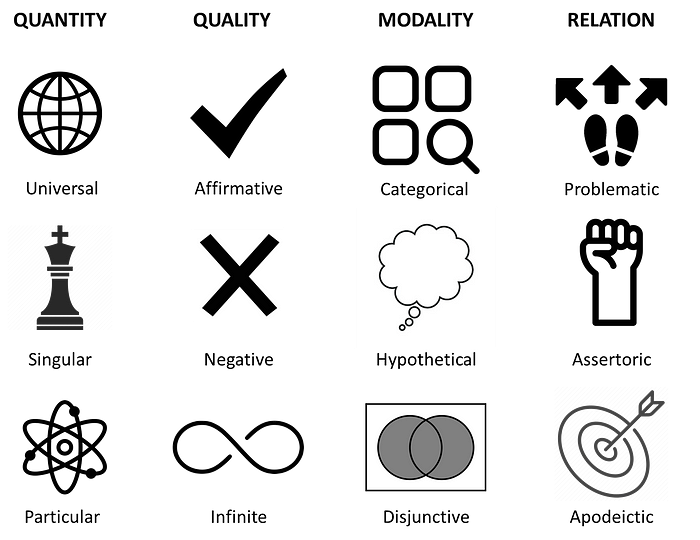The Epistemology of Immanuel Kant
How do we know and understand?

Immanuel Kant (1724–1804) was a German philosopher born and spent his life in Königsberg, the capital city of Prussia (the present-day Kaliningrad in Russia) who largely contributed to fields of epistemology, ethics, and aesthetics in philosophy through his three books, Critique of Pure Reason (Kritik der Reinen Vernunft), Critique of Practical Reason (Kritik der Praktischen Vernunft), and Critique of Judgment (Kritik der Urteilskraft). In this essay, I would like to zoom in on his contribution to epistemology.
The first time I read Kant’s philosophy, it was a bit hard to understand what he actually wanted to say, because as we know philosophy is not an easy subject to read it only once! However, the more I dug into his thinking, the more I must admit that his thinking is extraordinary.
His thinking actually laid the foundation of cognitive science, with epistemology as its root. Epistemology studies how humans think and understand, which is widely applied in education.
In this essay, the discussion starts from how Immanuel Kant put his position to refuse rationalism and empiricism; and then how he tried to unify them through his transcendental philosophy.
Kant’s Refusal and Synthesis of Rationalism and Empiricism
Kant’s main philosophical project was to refute and unify two opposing “schools” of philosophy, at the same time. One school is called rationalism, another school is called empiricism.

The philosophy of rationalism pioneered by René Descartes (1596–1650) and Gottfried Wilhelm Leibniz (1646–1716) generally believed that naturally, all humans have an “a priori” knowledge before they know anything without reference to sense experience. For example, all people know that the daytime is bright and the nighttime is dark. We don’t have to prove it because we already know about it. Such propositions are or are deduced from, innate ideas or principles.
On the other hand, the philosophy of empiricism pioneered by John Locke (1632–1704) and David Hume (1711–1776) believed that humans do not possess such “a priori” knowledge, instead, the knowledge is derived from sense (empirical) experience. John Locke believed that the mind without experience is possessing no knowledge whatsoever; he said the mind is “Tabula rasa” or an empty tablet. Therefore, the above statement that the daytime is bright and the nighttime is dark is understood after humans sense it first. They can see how bright or how dark it is through the visual sense. Therefore, only sense can make an understanding of the world.
Perhaps, the modern-time expression, “This mind intentionally left blank”, is adopted from the empiricism philosophy. 😊
Let’s imagine you were a philosopher at that time. What would you think and which one of these philosophical mainstream would you accept? Being as Immanuel Kant, he refused both these perspectives and rather started a new system. He even started his new thinking in his late 70s — what later we know as his critical philosophy. Before this period, known as his pre-critical philosophy, he followed the rationalism mainly of Christian Wolff (1679–1754) until his reading of David Hume awakened him from his “dogmatic slumber”.

What Kant proposed was unification. He found limitations of these opposing mainstream.
Kant’s Main Thinking
I tried to summarize all literature I have read and tried to simplify his thinking. This is what I think is the main thesis statement of Kant’s epistemology; that sense and understanding are unified. The role of sense in us is to make perception, whereas the role of understanding in us is to make concepts.
1 — Perception and concept are components of each other
Perception without a concept is “blind”. We can feel and sense something, however, without our understanding, we do not have a reference of what is happening. This can be thought as 6 blind people trying to identify an elephant but each of them comes up with different observations based on their limited senses. One identifies a rope (which is actually a tail), another identifies a snake (actually a trunk), and another thinks he touches a wall (actually the body) of the same elephant. If they know that they touch an elephant (know the concept), they can identify the different parts of the elephant.

On the other hand, a concept without perception is abstract. We may theorize lots of things, however, if we do not know how to describe it with our sense, we will never understand it. For example, we know that a triangle is a geometrical object which has three sides and three angles. If we explain it to someone who has never seen a picture of a triangle before, he/she will never understand it. Therefore, perception and concept are components to each other.
2 — Our knowledge is limited to our sense perception
Being central to his theory, Kant claimed that we actually do not know about something (an object) because that object itself cannot be known. In the middle of our journey in a desert, we might experience a phenomenon called Fata Morgana. When we are experiencing it, our sense sees that there is an oasis in front of us. In fact, it is just an illusion caused by the sun's reflection. We believe that there is an oasis, however, the oasis itself is not real. knowledge is only limited to our sense perception. Our sense perception brings an empirical experience that verifies that object, however, the object can never be thought of or even known.

3 — Our knowledge about something is objective, noumenon, “a priori”, and “Das Ding an Sich”
According to Kant, the object has the quality of being objective or noumenon, or in other words, the thing-in-itself (“Das Ding an Sich”), therefore it behaves as it is before we see (or “a priori”). Therefore, our intuition is also “a priori”. It is true because an object exists before we see it. However, our sense perception is subjective or a phenomenon. The way we sense an object makes that knowledge “a posteriori” as an experience. Except that we are the creator of that object, i.e. we create a Lamborghini car and we know exactly the dimensions, the components of the engines, and so on, we can claim that our knowledge is “a priori”. Note that being “a priori” also means being universal and necessary.
4 — Transcendental philosophy and the two faculties of mind
This is what Kant called his philosophy as a transcendental philosophy. His transcendentalism is divided into two frames; transcendental aesthetics and transcendental analytics. In the transcendental aesthetics lies our perception (“Vorstellung”) and in the transcendental analytics lies our concept (“Begriff”). In other words, he said, our mind consists of two faculties that accommodate these. The perception is accommodated by the faculty of sensing (“Sinnlichkeit”) and the concept is accommodated by the faculty of understanding (“Verstand”).

In transcendental aesthetics, there lies not only perception but also intuition (“Anschauung”) which is the mental state of being aware. To be able to sense something, we need to be aware. On the other hand, in transcendental analytics, there lies not only the concept but also the judgment (“Urteilbildung”).
5 — How our mind perceives and processes knowledge
Kant lived 100 years before Waldeyer-Hartz discovered in the late 1800s that it is the neuron that plays role in the transmission of impulse from the outside world and the brain that processes information carried by the neurons. However, the attempt of Kant to explain how knowledge is formed is a philosophical breakthrough at that time.
To Kant, the mind is equipped or programmed to process the sensory input, not an empty tablet, like claimed by Locke as “tabula rasa”. The mind perceives the world and creates the meaning of the world, whether or not it is meaningful to us. Our sense is not separated, they are all connected, unified, and interrelated. In fact, there are so many inputs about the world that come to us. Therefore, the faculties of the mind must have a structure to filter the bombardment of inputs into our perceptual experience — if not, all of them will cause confusion. The mind provides structure or principle that enables us to conceptualize what is going on in the sense, and then to formulate judgment about the perceptual experience. It can be the causal judgment that justifies cause and effect of a phenomenon, for example, that gravity pulls an object downward, or quantitative judgment that justifies whether or not everything is universal, for example when we see a green apple and we decide if all apple is green or just a coincidence.
6 — Categories of judgment
Judgment is the process of the mind to justify one’s sense perception that an object is known to have a certain quality or attribute, for example, the thought of “how small” or “how large”. The ability to judge is equivalent to the ability to think. According to Kant, when we make a judgment about something, our judgment tends to fall into one of the 12 categories. Kant followed Aristotle who was the first to propose the 10 categories of anything in general. Any object must have at least one of these categories as its characteristics to be an object of experience. Therefore, it cannot have two attributes that are contradictory with (or negate) each other.

7 — Reality is a creative product of the mind
According to Kant, reality does not exist before us. The reality that we can see, we can hear, or we can touch, is a subjective product of the mind. The mind produces subjective thoughts about the world around us, for example, one’s thinking that “flower is beautiful”, “bird is chirping”, or “feather is soft”. If we have never seen a flower, heard the birds, or touched a feather, we will never know the reality. For this, Kant introduced the idea of romanticism. Romanticism is about the imagination that one’s has.
Conclusion and Final Note
Immanuel Kant unified two opposing views on how humans acquire knowledge, empiricism and rationalism, into his new transcendental philosophy. In his philosophy, Kant claimed that perception and concept, which are both produced from different faculties of mind, are components to each other. In transcendental aesthetics, the mind must be aware enough to make intuition and then to make a sense perception. In transcendental analytics, the mind produces a concept and also a judgment about reality. All objects are not known to us, therefore they are “a priori” until we derive our knowledge from our sense experience then it becomes “a posteriori”. After that, our mind produces judgment which we categorize something into one of the 12 categories proposed by Kant. Finally, Kant claimed that reality is a subjective and creative product of the mind.

In the next years, many experiments were carried out to thoroughly understand how humans process information in their brains. Kant has laid a philosophical foundation for the developments of cognitive science.
References
Lecture videos of Arthur Holmes, Professor of Philosophy at Wheaton College:
